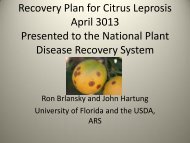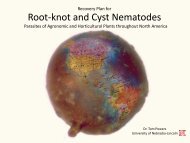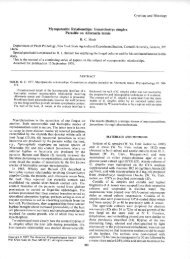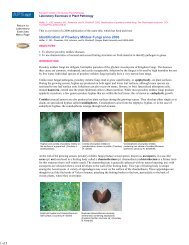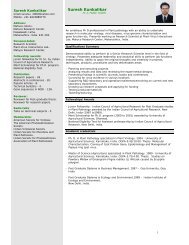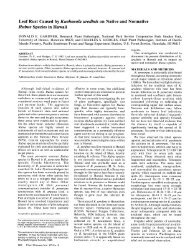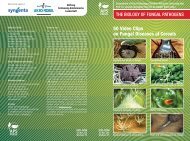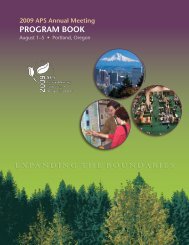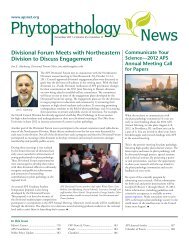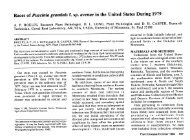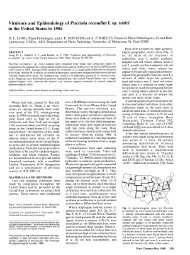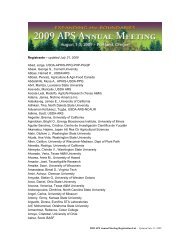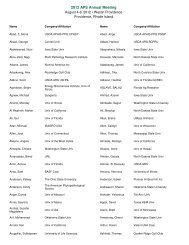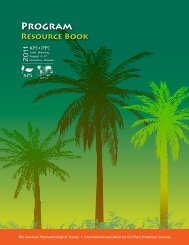view article - American Phytopathological Society
view article - American Phytopathological Society
view article - American Phytopathological Society
Create successful ePaper yourself
Turn your PDF publications into a flip-book with our unique Google optimized e-Paper software.
deposition or unfavorable conditions for spore germination and photosynthetic rates and lower stomatal conductances at ambient<br />
infection. Low severity in limed plots may result fran reduc- C0 2 (340 ppm), and significantly reduced levels of active<br />
tion of primary inoculumn from leaf litter or nutrient-related RUBISCO. Protein extrayion and subsequent total activation of<br />
differences in susceptibility. Results suggest little disease extracted RUBISCO with `C indicated a significant reduction<br />
impact on regeneration after seedlings achieve heights >30 cm. in the total amount of RUBISCO in infected leaves.<br />
70 74<br />
ALLOZYME DIFFERENTIATION AMONG INTERSTERILITY GROUPS OF<br />
HETEROBASIDION ANNOSUM ISOLATES FROM EUROPE. W.J. Otrosina,<br />
T.E. Chase, F.W. Cobb, Jr. and K. Korhonen. USDA Forest<br />
Service, Pacific Southwest Forest and Range Experiment Station,<br />
P.O. Box 245, Berkeley, CA 94701; Department of Plant<br />
Pathology, University of California,<br />
Institute,<br />
Berkeley; Finnish<br />
Helsinki,<br />
Forestry<br />
Finland.<br />
EFFECTS OF PLANT GROWTH REGULATORS ON ACREMONIUM COENOPHIAWUM<br />
GROWTH IN CULTURE. G. E. Huff, K. D. Gwinn, and C. E. Sams.<br />
Departments of Entomology and Plant Pathology and Plant and Soil<br />
Science, University of Tennessee, P.O. Box 1071, Knoxville TN<br />
37901.<br />
Growth of the fungal endophyte (Acremonium coenophialum Morgan-<br />
Starch gel electrophoresis was conducted for isolates from<br />
Finland, Germany, and Italy representing "P', "S", and "F"<br />
intersterility groups. No clear differences in mobilities were<br />
found between the "S" and "F" groups in any of the 12 loci<br />
analyzed. In general, mobilities for the MDH-2 locus for all<br />
European isolates were indentical to the North <strong>American</strong> "S"<br />
group. The ADH, IDH, and GDH locus showed consistent<br />
differences between the "P" and "S" or "F" groups. Other loci<br />
exhibit shared alleles among the intersterility groups, which<br />
is in contrast to the nearly total fixation present in most<br />
loci betweeen the "S" and "P" groups in western North America.<br />
Within the "S" and "P" groups, allele frequency differences are<br />
apparent between isolates from both continents.<br />
Jones and Gams) is stimulated<br />
fescue<br />
during<br />
(Festuca<br />
the transition<br />
arundinacea<br />
of<br />
Schreb.)<br />
tall<br />
from the vegetative to<br />
reproductive state. This study was initiated to determine if<br />
plant growth regulators elicit a growth response by the<br />
endophyte. Plant growth regulators, dicamba and gibberellic<br />
acid, had no significant effect on the growth rate of the<br />
endophyte in culture. Kinetin completely inhibited growth of<br />
the endophyte at a concentration of 100 4M, and reduced<br />
endophyte growth by 75-80% at 80 pTM. Other plant growth<br />
regulators are currently being examined to determine in vitro<br />
effects on endophyte growth.<br />
75<br />
A cultivar-specific elicitor of the hypersensitive response in soybean has been identified<br />
which is associated with expression of the avirulence gene, avrD. Mark 71 M. Stayton*,<br />
Stanley J. Tamaki**, and Noel Keen§ *Department of Molecular Biology, University<br />
SEEDLING Wyoming,<br />
of<br />
RESPONSE OF TWO FOREST TREE SPECIES TO Field<br />
Laramie,<br />
Station,<br />
WY<br />
Richmond,<br />
82071; "*Cleargene,<br />
CA 94804-4698;<br />
Inc.,<br />
§Department<br />
University of<br />
of<br />
California-Richmond<br />
VARYING DOSES OF OZONE<br />
Plant<br />
USING<br />
Pathology,<br />
OPEN-TOP<br />
University of<br />
CHAMBERS IN California at Riverside, Riverside, CA<br />
NORTHCENTRAL<br />
92521-0122.<br />
Davis, Dept. of Plant PENNSYLVANIA. Pathology, The M. Pennsylvania Simini, J.M. State Skelly, University, and D. D. A bacterially produced, low molecular weight compoand, has been idenitified which is a<br />
University Park, PA 16802<br />
cultivar SE compound specific<br />
is elicitor<br />
associated (SE) of<br />
with<br />
the hypersensitive<br />
the<br />
response<br />
expression<br />
in soybean. The<br />
of<br />
presence<br />
the<br />
of the<br />
avirulence<br />
Open-top chambers were<br />
gene,<br />
established<br />
avrD,<br />
at three sites in northern<br />
originally<br />
PA. Four 2- cloned<br />
year-old<br />
from Pseudomoassyringe<br />
seedlings each of Prunus<br />
pv. tomato<br />
serotina<br />
(Kobayashi<br />
Ehrh. and<br />
et.<br />
Liriodendron<br />
al. PNAS 86:157,<br />
tulipifera<br />
1989).<br />
L. were<br />
Expression<br />
planted<br />
of the<br />
in 1987<br />
avD<br />
in<br />
gene<br />
each<br />
in Ps.<br />
of 16<br />
pv. glycinea<br />
plots in a<br />
R4<br />
randomized<br />
alters the interaction<br />
complete<br />
of<br />
block<br />
the bacteria<br />
with<br />
design<br />
the cultivars<br />
at each<br />
IHarosoy'<br />
site. In<br />
and Norchief<br />
1988, the<br />
from<br />
seedlings<br />
compatible<br />
were<br />
to<br />
exposed<br />
incompatible.<br />
to ambient<br />
The presence<br />
air (no<br />
of<br />
chambers)<br />
the avirulence<br />
or to air<br />
gene,<br />
in filtered<br />
however,<br />
chambers<br />
does not<br />
which<br />
alter the<br />
contained<br />
compatible<br />
94%,<br />
interaction<br />
59% or 42%<br />
with the cultivar<br />
'Acme'. Furthermore,<br />
of<br />
E.<br />
the<br />
coli<br />
ozone<br />
cells overexpressing<br />
(03) in ambient<br />
the<br />
air.<br />
ayrD<br />
The<br />
gene<br />
number<br />
elicit the<br />
of hours<br />
hypersensitive<br />
which 03 exceeded 60 response<br />
ppb at the<br />
on exactly<br />
three<br />
the<br />
sites<br />
same<br />
was<br />
set of cultivars<br />
600, 646,<br />
as does<br />
and<br />
Ps.<br />
451<br />
pv. glycinea<br />
hrs, respectively.<br />
R4-avrD. The SE<br />
Ozone- compound<br />
induced<br />
can be<br />
stippling<br />
isolated from<br />
occurred<br />
cell-free<br />
on<br />
culture<br />
the adaxial<br />
supernatants<br />
leaf surface<br />
of E. coli,<br />
of<br />
P.s.<br />
both<br />
pv. tomaa<br />
species<br />
and<br />
at all !!.s. pv. glycinea<br />
sites. Differential<br />
R4 which express<br />
sensitivity<br />
the avrD<br />
was<br />
gene.<br />
found<br />
In<br />
among<br />
partially<br />
treatments<br />
purified extracts,<br />
and sites.<br />
the<br />
Injury<br />
SE<br />
was correlated compound causes a systemic<br />
growth<br />
positively necrosis<br />
were<br />
with only<br />
correlated<br />
ozone dose. in cultivars<br />
negatively<br />
Total height and basal diameter strains expressing the avrD gene. We have<br />
which<br />
purified,<br />
are<br />
by<br />
incompatible<br />
with 03 dose. reverse-phase<br />
with<br />
HPLC,<br />
bacterial<br />
active SE and have initiated an analysis of its chemical<br />
a biologically<br />
structure.<br />
72<br />
DISTRIBUTION AND INSECTICIDAL ACTIVITY OF ALKALOIDS IN FUNGAL<br />
ENDOPHYTE-INFECTED GRASSES. , L.P Bush, N. Fannin, G.C.M. Latch,<br />
D.D. Rowan, and B.A. Tapper. Plant Pathology, University of Kentucky, Lexington, Ky.<br />
40546; DSIR Palmerston North, New Zealand.<br />
A model for the gene-for-gene interaction between P.syringae and soybean.<br />
Tamaki*,<br />
Staley.,L<br />
Mark M. Stayton**<br />
California-Richmond<br />
and Donald Kobayashi§<br />
Field<br />
*Cleargene,<br />
Station,<br />
Inc.,<br />
Richmond,<br />
University<br />
CA<br />
of<br />
94804-4698; "*Department of<br />
Molecular Biology, University of Wyoming, Laramie, WY 82071; §Department of Plant<br />
Pathology, University of California at Riverside, Riverside, CA 92521-0122.<br />
The distribution of N-formyl and N-acetyl lolines, peramine, lolitrem and ergovaline was<br />
determined in Acremonium spp.-and Epichloe typ/i'na-infected cultivars and species<br />
Lolium<br />
of<br />
and<br />
Festuca,<br />
other grass genera. thirty of 34 host-fungus combinations produced alkaloids,<br />
peramine and ergovaline were the most common found alkaloids, while lolines and lolitrem<br />
were the least common. Three alkaloids (lolines, peramine, and ergovaline)<br />
A. coenophialum-infected<br />
were recovered from<br />
tall fescue and perennial ryegrass, while peramine, lolitrem, and<br />
ergovaline infected F. were longifolia. present<br />
Other<br />
in A.<br />
host-fungus<br />
lolii infected perennial<br />
combinations<br />
ryegrass, tall fescue, and in<br />
produces<br />
E. typhina<br />
only one or two of these<br />
alkaloid types. Aphid bioassays, using infected grsss stems, indicated that loline alkaloids were<br />
toxic to Rhiopalosiphusm padi (Rp) and Schu'zaphiis graminum (Sg); peramine was toxic only to<br />
Sg and ergovaline was not toxic to either aphid. Lolitrem was not toxic to Rp, but it could not<br />
be determined if the alkaloid was toxic to Sg as peraimine was always present in the same<br />
infected grasses. The relationship of alkaloid synthesis in infected grasses and resistance to<br />
In gene-for-gene systems the interaction between a dominant<br />
corresponding<br />
resistance<br />
avirulence<br />
gene in<br />
gene<br />
the host<br />
in the<br />
and<br />
pathogen results in an incompatible interaction<br />
characterized by the hypersensitive response (HR). We have isolated a low molecular<br />
cultivar-specific<br />
weight<br />
elici'or (SE) from a phytopathogenic bacterium; suggesting that the<br />
primary gene product of the avirulence gene is not directly involved in the recognitional<br />
event. Rather, the avirulence protein is predicted to possess a catalytic<br />
the synthesis<br />
activity involved<br />
of the<br />
in<br />
specific elicitor. The<br />
receptor,<br />
current<br />
the resistance<br />
models<br />
gene product,<br />
hypothesize<br />
which interacts directly with<br />
the<br />
the<br />
presence<br />
specific elicitor<br />
of a host<br />
triggers the<br />
and<br />
cascade of events manifested as an HR. Alternatively, the target within the plant<br />
for the specific elicitor may not be a dedicated receptor but may play other roles in plant<br />
metabolism. The biological effect of the SE shows parallels those of host-specific toxins<br />
produced by various IIelm~ialisnthsoriuim spp. and Alsnr spp. We will discuss the<br />
similarities in biological activity between the specific elicitor and various host-specific<br />
toxins and propose a working hypothesis which may account for both types of specificity.<br />
herbivory will be diacussed.<br />
73 OXALIC ACID, K 2 HP0 4 AND K 3 PO 4 AS INDUCERS OF SYSTEMIC<br />
RESISTANCE AGAINST DISEASES CAUSED BY FUNGI, BACTERIA, AND<br />
F-OIDSYNTmESIS AND STOM4ATAL RESPONSE IN A SUSCEPTIBLE ALFALFA VIRUSES IN CUCUMBER. Mucharromah and J. Kuc, Dept. of Plant<br />
CLONE INFETE WITH VERFTICILI.JtI4 ALBO-ATRUM. B.W. Pennvpacker, Pathology, University of Kentucky, Lexington, Kentucky 40546<br />
D.P. Knievel, K.T. Leath and E.J. Pell, Penn State Univ. and<br />
USDA~-ARS, U.S. Regional Pasture Jab, Univ. Park, Pa. 16B02. Oxalic acid, K 2 HPO 4 and K 3 PO4, induce systemic resistance to<br />
Phiotosynthesis was measured on a susceptible cucumber<br />
alfalfa<br />
anthracnose<br />
clone caused by Colletotrichum<br />
effectively as<br />
lagenarium<br />
induction with<br />
as<br />
infected with V_. albo-atrums<br />
_C.<br />
and<br />
lagen_,<br />
compared<br />
arium.<br />
to<br />
Spraying<br />
that of control<br />
with<br />
either oxalic acid, K2 HPO4 or<br />
plants.<br />
K3 PO4 on<br />
Infected<br />
the abaxial<br />
plants surface<br />
had symptoms of Verticillium wilt, but of leafI also induced<br />
photosynthesis<br />
systemic resistance<br />
was determined<br />
against<br />
only on asymptcomatic leaves. The Cladosporium cucumerinum,<br />
leaf being measured<br />
tobacco necrosis<br />
was placed<br />
virus,<br />
in a sampling ch1amber and Sphaerotheca fuliginea,<br />
exposed Pseudomonas to ca. 750 lachrvmans,<br />
ppm CO2. Sequential measurements were Mycosphaerella<br />
taken<br />
melonis,<br />
at 15 sec.<br />
cucumber<br />
intervals mosaic<br />
for<br />
virus<br />
20 min. and Erwinia<br />
as 032 was depleted by tracheiphila.<br />
photosynthesis. This evidence<br />
A/Ci supports<br />
response the<br />
curve hypothesis<br />
analysis that<br />
was used, which plants have the potential<br />
allowed for<br />
in vivo<br />
resistance<br />
assessment to many<br />
of the<br />
pathogens,<br />
amount of active RUBISCO in and that defense mechanisms can be induced by stress as well<br />
the leaf. Leaves on infected plants had significantly lower as by infection.<br />
1144 PHYTOPATHOLOGY<br />
76



